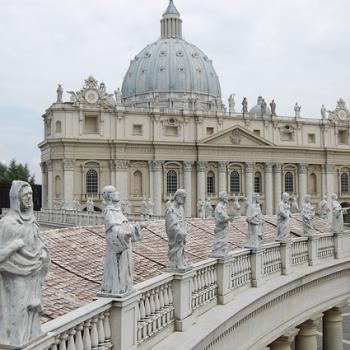
Days ago I inadvertently knocked over a powder keg with my frustrated rant about bad Christian art. Apparently a lot of people agree with me, as that rant has been shared more than any of my other much better posts. And in the comments on these shares, I’ve seen many people asking questions. What should we do? How should we change? What is art, anyway? Isn’t it subjective? Who gets to decide what art is good and what art is bad? These are fantastic questions; I’ve already mentioned that I love talking about art and the study of aesthetics. Up until this point I never met anyone who enjoyed hearing about art half as much as I enjoyed talking about it. Now that I’ve got your attention, I would like to take some cursory answers to these questions and expand on them. Yesterday I gave one answer as to how you can objectively know if art is good or bad: that good art does what it’s supposed to do and bad art doesn’t do what it’s supposed to do. I was speaking in the context of Christian devotional art which, whatever else it does, is meant to speak about Christ and set the mood for prayer. Today, I want to talk about three characteristics found in good art, the exclusion of which definitely makes art bad.
First of all, good art shows us new perspectives. If I look at a sunflower, I know what it’s like to be myself, looking at a sunflower. If I look at one of Van Gogh’s famous paintings of sunflowers, I’m learning what it’s like to be Van Gogh, looking at a sunflower. Someone else– someone who lived long ago, who spoke a different language from me and struggled with mental issues different from my own, is holding up a sunflower and showing it to me from his own viewpoint. I have a new perspective on how to feel about sunflowers, about how they look and about how they make someone feel. I have a new view of the nature of what it is to be alive, to be a temporary thing that is going to die quickly, and even about the color yellow and different colors that can be mixed with yellow. Bad art doesn’t show any new perspective. It might portray a subject badly, or it might take the easy way out and portray exactly what the artist thinks people would like to see, rather than his own unique perspective in a clear and interesting way. A bad artist does not help me to see a sunflower differently, and he doesn’t tell me what it’s like to be a different person seeing a sunflower. My vision stops at the portrayal of the sunflower. It may be pretty in its way, but there’s nothing to ponder and nothing new to learn.
Good art expresses that which is more universal, through a particular instance. That’s a fancy way of saying that good art displays one specific thing or a few specific things– one landscape, a few oranges, a cast of characters– so truthfully and so beautifully that it says something about the nature of things in general: the nature of what it is to be a person, of what fruit is, of what a landscape is, of what color and light are. It goes from the specific to the universal and the universal back to the specific. I can learn about what it is to be a man, an ambitious and sinful man, a warrior and a human being from watching a talented actor portray Macbeth. I can learn about myself by watching a fictional character who is not very much like me in some ways, but is in others. Bad art, on the other hand, does not provide a good, solid, concrete particular to lead me to the universal; it doesn’t concern itself with universals at all. To return to beating our dead horse of the week: I can’t learn about myself from watching Grace cry without smearing her makeup in God’s Not Dead 2, because Grace is not a good particular. She has no characteristics to speak of. She’s not a real person, not even a realistic fictional person. The opportunity to learn about human nature in any way is lost. Bad art often attempts to bring us the universal through using many different badly portrayed particulars. Think of any children’s book that presents a “diverse group” of boring characters, one of whom is black, one of whom is white, one of whom is disabled and one of whom is a tomboyish female. The bad artist is attempting to give everyone something to identify with– black children with the black character, tomboyish girls with the tomboyish girl, and so on. A good artist will give us truthful, beautiful and interesting characters that may be different from us in any number of ways, and leads us to learn about humanity through them.
Good art also broadens our empathy. It leads us to put ourselves in others’ shoes and feel for people who are not like us. This is very good just in itself, and it also opens doors for other kinds of good. A person who has never heard of Christ or Mary can look at Michelangelo’s Pieta and feel Mary’s grief. She can begin to suffer with a person she did not previously know existed, because she connects with the compelling portrayal of suffering in the piece of art. Now we’ve opened a door to talk about what the piece of art is about, the story it tells and the things we believe about Christ and Mary. Art is bad insofar as it narrows the opportunity for empathy. This kind of art does not provide a door for conversation except by accident, because nobody wants to talk about it except to mock it, and as much as I like mocking and ranting and making fun of song lyrics, it doesn’t get us very far. Think of the worst religious art you’ve ever seen. Maybe the cartoons in a children’s religion textbook, or a proselytizing tract. The kind of artwork that makes Jesus look like Kenny Loggins. Now contrast that with looking at the Pieta. Looking at the bad art leaves you confused and wanting to mock or dismiss everyone involved; not only can you not empathize with the person depicted, you can’t even empathize with the artist or the person using the image. It becomes extremely difficult to read the book or tract and take it seriously. Empathy, devotion and the chance at hearing out somebody’s ideas have all been squashed by the horrible art.
Good art draws people to think from different perspectives, and about universal things through particulars. It deepens empathy and helps us to open up conversation. Bad art doesn’t inspire thought, it doesn’t teach, it doesn’t open the same doors to conversation and it doesn’t lead us to empathize with one another. These are only some of the major reasons why good art, whether it’s directly to do with Christianity or not, is so important for society and especially for people of faith. There’s far more to say, but we’ll leave it at that for now.
(Image: The Vase With Twelve Sunflowers by Vincent Van Gogh, courtesy of ibiblio.org)













